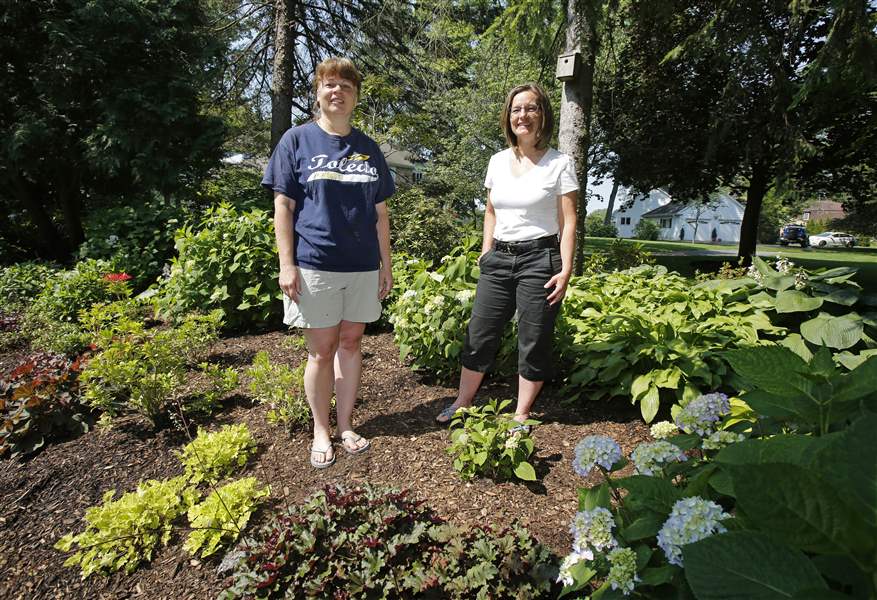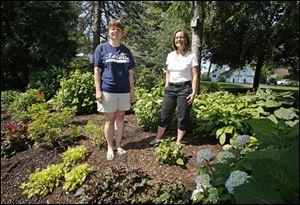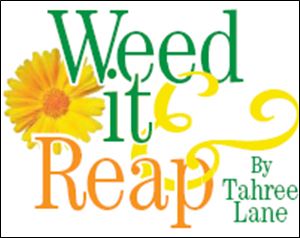
WEED IT & REAP
Neighbors grow into great friends through gardening
6/26/2013
Amy Stolarski, left, and Lyn Tucholski pose in the shared garden between their front yards on Obee Road in Monclova Township.
The Blade/Dave Zapotosky
Buy This Image

Amy Stolarski, left, and Lyn Tucholski pose in the shared garden between their front yards on Obee Road in Monclova Township.
Names: Amy Stolarski, accounting and finance at Dana Corp., and Lyn Tucholski, homemaker, next-door neighbors living on the 25-acre Springbrook Lake in Waterville Township.
Garden specs: Amy: 1.5 acres; Lyn: 1.4 acres. Our homes are surrounded by garden plots, Amy has more than 150 types of hostas interspersed with dark-leafed coral bells on a steep hill leading to the lake. Dealing with erosion is a constant battle. Lyn has terraced beds of hostas and roses below the house, and a 10-by-6-foot bed with 55 mini-hosta varieties. We have joint gardens along our properties, including a winding bed between our long driveways that has more than 25 hydrangeas including our favorite variety, Endless Summer, which bears white, pink, and blue flowers all season.
PHOTO GALLERY: Amy Stolarski and Lyn Tucholski's hosta garden
When did you start gardening? Amy: Before we moved here 17 years ago, I had a full-sun garden. This is almost full shade. Lyn: I’d maintained gardens at previous homes but when we moved here 10 years ago, I learned to enjoy being outside for hours on end. Amy and I design, go on plant-shopping trips, garden, and weed together.
What do you grow? About 95 percent is perennials; the rest, annuals, mostly in pots, to provide year-round color. Amy has more than 500 varieties of hostas and often plants in a grid, keeping detailed maps of where each plant is. More than 40 varieties coral bells (the newer varieties come in several colors and can tolerate more sun), 15 to 20 roses, ornamental grasses, hydrangeas (Lyn has a climbing one that can get to 30-feet-tall). Some tomatoes and peppers which we can. Being in the Oak Openings region, we have some sand but great dirt.
Favorite plant: Hostas, of course. We recognize them by name and refer to them almost as family members. They take care of themselves and range in size from an inch across (Cat’s Eye), to a couple of inches (the dark green Itsy Bitsy Spider) to five-feet in diameter (Blue Mammoth). One plant, Emerald Tiara, has been divided over the years into 45 plants, and within two years, the divisions were full-sized plants. You don’t know until you divide them how soon they’ll bounce back to maturity. We’ve noticed that blue hostas tend to green up when located in a sunny spot. When we shop, we look for plants that are large enough to split, and we refer to the updated list of all Amy’s varieties that she keeps in her purse.
And hostas have great names, such as Cracker Crumbs, Tears of Joy, Mouse Ears, Illicit Affair, Wheee, Radio Waves, Sum and Substance.

Give us a tip: Lyn; I overwinter potted begonias, geraniums, vinca vines, and spikes by clipping them back and storing the pots in our partially-heated garage. They’ll also survive in a cool basement. I water them once a month. In March, I water them for two to three weeks, then give them a drink of Miracle-Gro, and bring them inside. Last year, we discovered that a chipmunk had made its home in a box of geraniums we’d brought in. Also, to cut down on weeds, we’re trying to plant things closer together. And here’s how to get more years’ out of mulch: first lay down 10 to 12 layers of newspapers, then spread the mulch on it. It lets water through and slowly degrades.
Hours spent gardening per week: Approximately 15 for each of us during spring, less as the summer goes on.
Challenges: Chipmunks — their holes are everywhere including through the roots of our plants — along with weeds and poison ivy.
Annual expense: Less than $500 a year for each, except for expenses such as tree removal. Amy has lost 17 ash trees and had another 20-some removed; Lyn had seven ash trees taken down. The most Amy has paid for a hosta was $50 for Risky Business the year it was introduced. A few years later, Lyn bought it for $10 or $15.
We’re proud of: We’ve helped numerous people start gardens and kept meticulous records.
What do you get out of gardening? Amy: It’s so peaceful. And we have shared and collaborated on so much. A few weekends ago, we dug up a bed that we thought was too big and too much work and replanted the hostas closer together, then turned a portion back into grass. Lyn: The friendship we have forged through our love of gardening. Working together we can be quiet for long stretches of time or chatting about everything. We borrow from each other’s garages. And if a tree goes down, all four of us (with our husbands Roger Tucholski and Ron Shultz ) jump in and then before you know it, we’re putting dinner together.